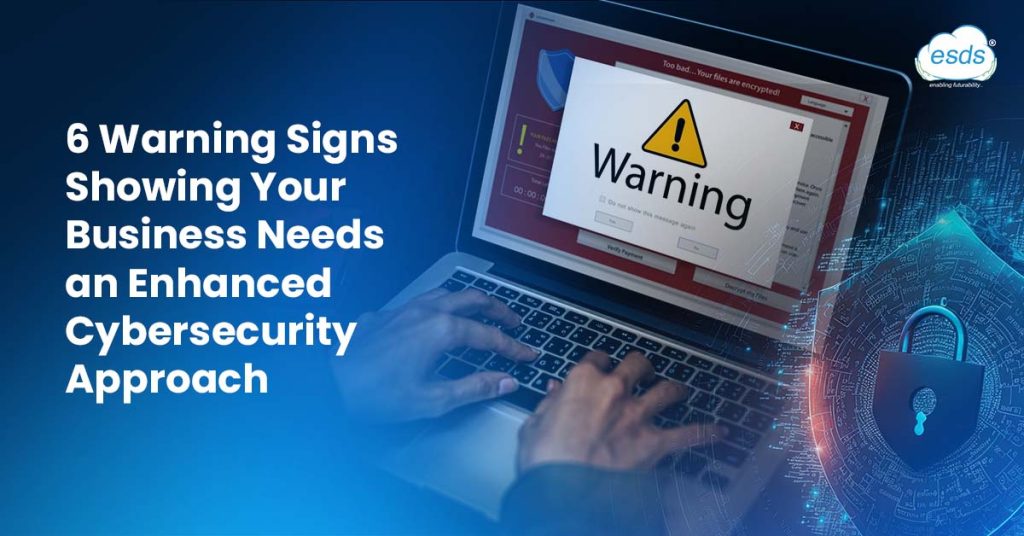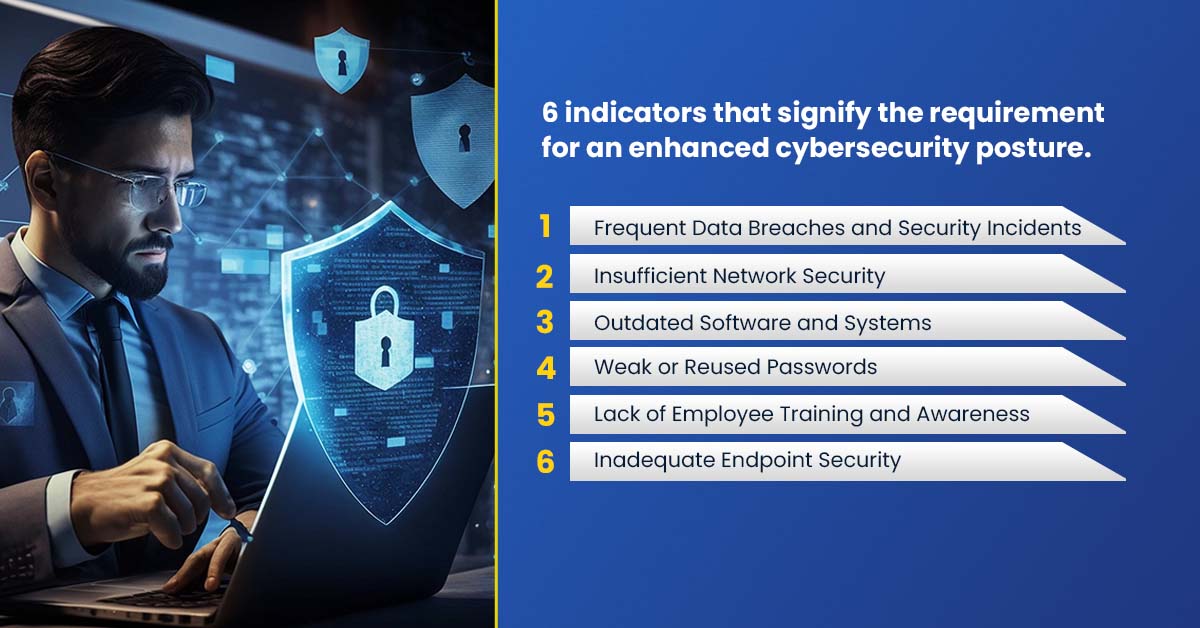6 warning signs showing your business needs an enhanced Cybersecurity Approach

In the modern era, cybersecurity is not just a buzzword but a fundamental necessity. As cyber threats continue to evolve in complexity and frequency, businesses must remain vigilant and adaptable in their defense strategies. In the vast digital landscape where businesses navigate the currents of innovation, there’s an unseen force at play – cyber threats. These threats, like shadows in the digital alleyways, evolve and adapt, posing challenges to the security of your business. Today, we explore the signs that your business might be sending distress signals, urging a reevaluation of its cybersecurity strategy. From subtle whispers to glaring red flags, these signs serve as beacons guiding you toward a more fortified digital defense. Join us as we decipher the language of cybersecurity readiness and embark on a journey to secure the integrity of your business in an ever-connected.
Amidst the symphony of data and digital transactions, the orchestra of cyber threats plays a constant undertone. As businesses embrace the digital age, the need for an impervious shield against these threats becomes paramount. This blog unravels the narrative of six crucial indicators that illuminate potential chinks in your cybersecurity armor. From the subtle nuances of irregularities to the glaring signs of vulnerability, recognizing these markers is akin to deciphering a digital Morse code. Join us in this exploration of fortifying your digital fortress, where vigilance and preparedness are the keystones to ensure your business stands resilient against the unseen currents of the cyber world.
Here are six compelling indicators that signify the requirement for an enhanced cybersecurity posture

1. Frequent Data Breaches and Cybersecurity Incidents
If your organization experiences recurrent data breaches and security incidents, it’s a clear signal that your current cybersecurity measures may be inadequate. With the surge in cyberattacks, which encompass unauthorized database access, phishing attacks, and ransomware infections, maintaining a strong cybersecurity stance is critical. Strengthening network security, implementing stringent access controls, and regularly updating software and systems are essential steps to thwart emerging threats.
In recent years, there has been a significant uptick in data breaches and security incidents affecting businesses of all sizes and industries. These incidents not only result in financial losses but also tarnish a company’s reputation and have potential legal consequences. In this section, we explore the implications of frequent data breaches and security incidents, emphasizing the need for proactive cybersecurity measures.
2. Insufficient Network Security
Neglecting network security can expose your business to a range of vulnerabilities. This includes unsecured Wi-Fi networks, a lack of intrusion detection systems, and outdated firewall rules. Enhance your network security by securing Wi-Fi networks, investing in robust firewalls and intrusion detection systems, and conducting regular security audits to identify and rectify vulnerabilities.
Effective network security is the foundation of a robust cybersecurity posture. Unfortunately, insufficient network security can leave organizations vulnerable to a wide range of cyber threats. In this section, we explore common network security shortcomings and how to address them.
Common Network Security Weaknesses
- Unsecured Wi-Fi Networks: Unsecured Wi-Fi networks are open invitations to cybercriminals. Weak or default passwords and outdated encryption protocols make it relatively easy for attackers to gain unauthorized access to your network.
- Lack of Intrusion Detection Systems (IDS): Intrusion Detection Systems play a critical role in identifying suspicious activities on your network. Without proper IDS in place, you may not detect a breach until it’s too late.
- Outdated Firewall Rules: Firewall rules must evolve to address new threats. Using outdated rules can leave vulnerabilities open, allowing cybercriminals to exploit weaknesses in your network security.
3. Outdated Software and Systems
Running outdated software and systems is like leaving your front door open for cybercriminals. Aging software and operating systems are more susceptible to vulnerabilities, as software developers often discontinue support and updates for older versions. Cybercriminals actively exploit such vulnerabilities, gaining access to your systems to steal data and launch attacks.
If you find yourself using outdated software, such as an unsupported operating system or obsolete applications, it’s time to upgrade. Thus, ensure you’re using the latest versions of all software and systems and regularly apply security patches and updates. In addition to using the newest software version, consider transitioning to cloud-based solutions with built-in security features and easier to maintain and update.
Outdated software and systems present significant security risks. In this section, we delve into the dangers of relying on obsolete technology and the steps you can take to mitigate these risks.
The Perils of Outdated Software
The use of outdated software and systems poses several serious risks:
- Vulnerabilities: As software and operating systems age, developers discontinue support and stop releasing updates. This leaves known vulnerabilities unpatched, creating opportunities for cybercriminals to exploit these weaknesses.
- Compatibility Issues: Running outdated software can lead to compatibility issues with newer applications and hardware. This can result in performance problems and security vulnerabilities.
- Legal and Regulatory Compliance: Depending on your industry, using outdated software may lead to non-compliance with industry-specific regulations and standards, potentially resulting in penalties and legal consequences.
4. Weak or Reused Passwords
Passwords are often the first line of defense for most of your online accounts, and weak or reused passwords can be an open invitation for cybercriminals. If you’re still using easily guessable passwords like “123456” or “password” or using the same password across multiple accounts, your cybersecurity needs a serious upgrade. Here’s how to strengthen your password security:
Weak passwords are an Achilles’ heel in cybersecurity. In this section, we explore the risks associated with weak or reused passwords and provide strategies to bolster your password security.
The Vulnerability of Weak Passwords
- Easily Guessable: Weak passwords, such as “password,” “123456,” or common words, are easily guessable by cybercriminals, especially with the help of automated tools.
- Password Reuse: Using the same password across multiple accounts increases your vulnerability. If one account is compromised, all accounts using the same password are at risk.
5. Lack of Employee Training and Awareness
Your cybersecurity is only as strong as your weakest link, and often, that weak link is human error. Cybercriminals frequently employ social engineering tactics like phishing emails to trick employees into revealing critical company information or clicking on malicious links. Thus, your organization may be at risk if your employees lack proper training and awareness of these threats.
Investing in cybersecurity training and awareness programs for your employees is a proactive approach to upgrading your security. Provide a comprehensive cybersecurity training program for all employees, covering topics such as identifying phishing emails, secure password practices, data handling procedures, and cyber incident planning and response.
The Human Factor in Cybersecurity
Human error is a persistent challenge in cybersecurity. Employees, often unintentionally, contribute to security breaches through actions like falling for phishing scams, using weak passwords, and mishandling sensitive data. In this section, we explore the human factor in cybersecurity and strategies to mitigate risks.
6. Inadequate Endpoint Security
Endpoints, which include laptops, desktops, and mobile devices, are often the entry points for cyber-attacks. If you’ve noticed that your organization’s endpoint security is lacking or if you rely solely on traditional antivirus software, it’s time to upgrade your cybersecurity strategy.
In this section, we explore the significance of endpoint security and provide guidance on how to strengthen it to protect your organization effectively.
The Vulnerability of Endpoints
Endpoints, such as laptops and mobile devices, are often the entry points for cyber-attacks. Cybercriminals target endpoints to gain access to an organization’s network, steal data, or launch attacks. Traditional antivirus software may not provide sufficient protection against modern threats like advanced malware and zero-day vulnerabilities.
Our verdict
Staying vigilant and proactive about cybersecurity is paramount, especially in today’s evolving cyber threats. Recognizing the signs your cybersecurity needs upgrading and taking the necessary steps to address vulnerabilities can significantly reduce the risk of falling prey to cyberattacks.
ESDS’ security professionals can help you improve your cybersecurity maturity over time across all the above facets and many more. Our cybersecurity experts can assist your business with comprehensive managed security services and also help you achieve compliance with regulatory requirements and cybersecurity standards. The best part is that this service is available at an unmatched price and flexibility in the market.
- Why does your business need Endpoint Detection and Response (EDR)? - May 15, 2024
- Are your business endpoints completely secure? - March 26, 2024
- Is Colocation key to transforming your data center management strategy? - March 22, 2024
